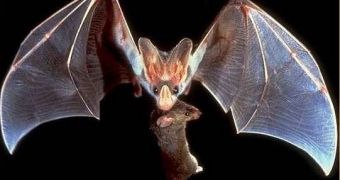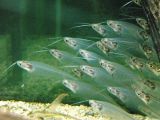Ghosts do not exist only in fiction movies and horror stories. They can be real, even if they do or do not induce nightmares and sleep impairments.
1.Indeed, the best species to impersonate a ghost is the bat. The ghost Bat (Macroderma gigas), also named the Australian False Vampire Bat, is endemic to Australia and its extremely thin patagyum (wing membrane) makes it "glow" ghostly at night. The gray fur on their backs and the white one on their undersides intensify their ghostly image.
This is the largest bat in the group of those called microchiroptera (that excludes the huge flying foxes) and it is a vicious predator, consuming besides insects frogs, lizards and mice, but also other bats.
2.There is a ghost lizard (Eurycea spealeus) which despite its name, is not a lizard, but a salamander. The "ghost" name is well deserved, as the animal, living in caves, is completely depigmented, with a translucent body. The other name could be better: grotto salamander.
3.In southern Africa ghost frogs (Heleophryne genus) are to be found. These frogs inhabit mountain streams and there's nothing ghostly in their look. The name is believed to come from the fact that they inhabit the Skeleton Gorge.
4.Ghost crabs belong to the genus Ocypode. They are common on the beaches between sunset and dawn.
Their name comes from their ability to get out of your sight almost instantly, at velocities of up to 10 mi (16 km) per hour, while executing sudden directional changes.
5.The ghost knifefishes (family Apteronotidae) inhabit South American freshwaters. There are 47 species assigned to 13 genera. The longest species can be 1.3 m (4.2 ft). They are nocturnal and have small eyes. The ghost knifefishes use a high frequency tone-type electric organ discharge (EOD) (over 750 Hz at maturity) to communicate.
6.The ghost tiger beetle (Cicindela lepida) belongs to a group of fearsome carnivore beetle endowed with huge jaws. The species gets its name from its whitish color.
7.Ghost insects form an odder called Phasmatodea (also named stick insects, walking sticks and leaf insects). The body shape, patterns and color in these insects imitate sticks or leaves. They even have movements mimicking a twig or leaf blown by the wind, so that they are extremely hard to detect in the environment. Some species are extremely toxic.
8.The ghost fish, Kryptopterus bicirrhis, also named glass catfish gets its name from is transparent body, up to 15 cm (6 in), a common aquarium species from Southeast Asia. The ghost fish turns milky white when dead, thus its transparency is actively maintained.
9.The ghost Moth (Hepialus humuli) is common in Europe. Both wing pairs are pure white. The name comes from the display flight dance of the male, a hover combining slowly rising and falling.
10.If ghosts give you nightmares, spiders can do that, too. The ghost spider (Anyphaena californica) lives in southern US. The tiny arachnid gets its name from the translucent look of its body.

 14 DAY TRIAL //
14 DAY TRIAL // 
